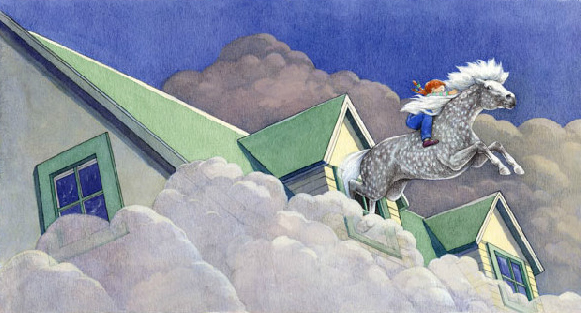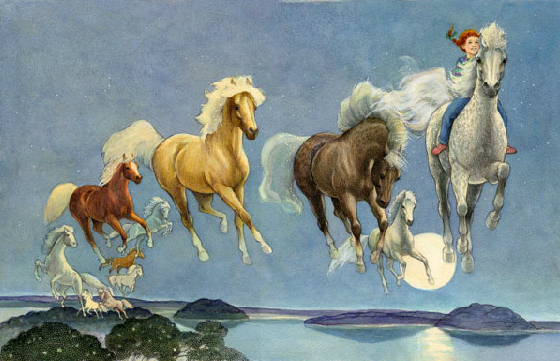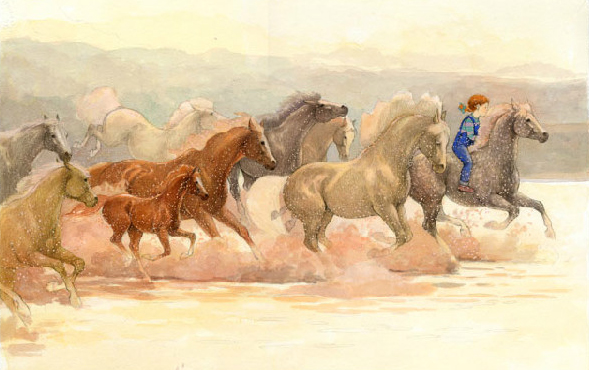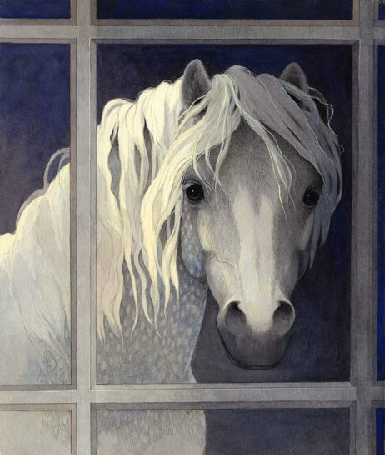Dream Jobs: Children’s Book Illustrator Susan Jeffers
Susan Jeffers has made her career illustrating children’s books – many of them about horses.
by Karen Braschayko
Your local library probably holds several of Susan Jeffers’ children’s books, since she has illustrated around 40 of them. From portraying classics like Black Beauty, The Nutcracker, and the poems of Robert Frost to depicting original tales about animals and the children who love them, Susan Jeffers creates pictures that carry away the imaginations of young readers. Her books have emerged from our cultural context and helped to create even more stories for children to adore.

Susan Jeffers' art is strongly influenced by her love of horses and other animals.
Notably, Jeffers’ works about horses capture the fascination that many children have growing up – the desire for the freedom we can find on the back of a horse. As an equestrian herself, Jeffers understands the deep love riders have for their equine partners and displays her great respect for animals. She expanded on Marguerite Henry’s classics with My Chincoteague Pony. This story of a girl who yearns for pony of her own and cultivates a plan to get one is based on Jeffers’ experience visiting the annual Chincoteague Pony Auction.
Jeffers has won many awards and much recognition. In 1974, she won the Caldecott Honor, the most prestigious award for an American children’s picture book. Her work has been exhibited several museums, including the Metropolitan Museum of Art in New York City. Brother Eagle, Sister Sky became a New York Times Best Seller, which as a vote by people seeking her work is her favorite achievement.
Still creating at her home in Westchester County, New York, Jeffers continues to develop her body of art. Here she explains how she formed her career of illustrating beloved children’s stories and continues to enjoy life with horses.
Karen Braschayko for Equitrekking: What is your background with horses? How did you fall in love with equines?
Susan Jeffers: I am trying to remember when I realized that horses were my love. I am beginning to feel that you are born this way, no matter when it shows up in your life.
.jpg)
Susan Jeffers wrote and illustrated My Pony, the tale of a girl who can have her own pony through the power of imagination and art.
There was a boy’s academy in the town where I grew up, and it had a riding arena on the main street. I had to pass it every day with my sister on our walk to school. We would see horses being exercised every morning and afternoon. I came to know all their names and colors, and I drew them on my papers in school. Those are my earliest memories of my inner landscape.

Jeffers' My Pony reminds readers of horse-centered childhood dreams.
I borrowed horses until I could afford to own one. I read everything I could find about them and their care.
In my later years, I discovered the work of John Lyons. I could not get my horse to ride safely in a van, and he was always verging on dumping me because he was so frightened. Lyons’ philosophy changed my horse life forever. I was able to trailer my horse safely and ride outside on a windy day knowing my horse was with me, not his fear. I recommend his principles for everyone. I wish I had found him years before, but honestly I think that work was just getting started. It is, first of all, safe for you and second, safe for the horse. And best of all, it is kind.
Equitrekking: How did you get started writing and illustrating? How did you weave your passion for horses into your career?
Susan Jeffers: I would say that because our mother was an artist, I became an artist. I am not a writer, so I write only when there is no choice. My mother used her art every day in her conversations with my sister and me. She talked about the way things cast a shadow, and she asked questions like, “What exact color was that? Is it blue or purple blue?” We made door decorations for Christmas, doll clothes and fire prevention posters.
She brought the outside world into the house in the form of visual problems. This was not without strife. I fought her observation that the human eye in profile was not as the Egyptians had painted it but rather as she drew it. Mother knew when to simply let us grow on our own.
When my sister and I went to school, because of this early exposure we were always declared “class artist.”

The horse-crazy girl in My Pony can ride for endless miles through her daydreams and drawings.
Judy and I are very different individuals. I am convinced that because I have the ability to sit for hours, I continued to draw and paint. Judy does not like to be still, and instead she became a physical education teacher. She was always the best athlete. What is rare is that we shared the same love of horses.
I went to Pratt Institute for my education. My parents were brave to send me there for a fine art education rather than hedging their bet and sending me to a college with a minor in art. I spent every day drawing and painting! I recommend this to anyone who wants to be in the visual arts. It is an irreplaceable time to learn and to develop your own vision.

My Pony was inspired by Jeffers' childhood yearning for a pony and drawing fantasy horses of her own.
After graduation, I worked for three years in the children’s department of a publishing house designing children’s books. I learned how they work, don’t work, and how to produce them. Eventually, I left regular employment to do my own books. Children’s books are the closest thing to fine art that you can get paid for.
When I left Macmillan Publishers I had $800 in the bank, a very inexpensive apartment in Brooklyn, and a VW Bug. I took any job that was offered to me from the contacts I had made in publishing. They were mostly designing book jackets, a very stressful job. It was quite scary, and the fright helped me to stay focused on getting the next assignment.
Eventually, I was offered a whole book. I learned my biggest lesson there: If you don’t love the story, don’t do it. It took forever to complete, and I was miserable the whole time. It was not a success on any level. My next book was The Buried Moon by Joseph Jacobs, a wild and visually gripping folk tale. I loved it! However, it did not earn any money either. So I went back to the jackets.
.jpg)
Susan Jeffers, right, and her sister Judy are still "partners in all things equine." Here they had the chance to exercise draft-cross field hunters.
The next idea was a poem in public domain, Three Jovial Huntsmen, which was fascinating and mysterious. I could not get a grip on it, however. I did the drawings for it, and they were not successful. The publisher and I went to press, and there we decided not to publish because it did not look good enough to promote.
I went home and got a job as an art teacher.
About a year later, my brave publisher called to ask if I wanted to try again. It is amazing what stepping back from a problem can do. I started again and the book fell into place.
The book won the Caldecott Honor and the Pomme D’Or Biennale from Bratislava. This meant that I was finally on the bookseller’s map. It does not mean, certainly, that all my books do well, but at least I am considered.
This is my dream job. What I saw in these stories were all the things I loved to draw and paint. Horses, Black Beauty, dogs, Lassie, McDuff, and people – it’s heaven!

Jeffers says that if she had gotten her wish for a horse right away, she may not have had the time to draw and study them.
I am a landscape painter in my spare time, and illustrating children’s books is another opportunity to use what I learn. I study portrait and figure drawing a few times a week as well. It is my busman’s holiday.
Equitrekking: How do you get inspired for your equine illustrations? What is your process for creating them?
Susan Jeffers: Horses are always in my mind. I do not have to go far to be inspired. If I am stuck, I will consult my favorite painters of horses, such as Alfred Munnings and Wesley Dennis. They are not simply horse painters but Painters. They paint a whole scene, full of emotion and desire.
I have three large file folders that are full of horse anatomy with wonderful photos of every angle. Then I take a trip to see a horse in the flesh, to feel the depth of the angles and the curve of the muscles.
Equitrekking: What is a typical workday like for you?
Susan Jeffers: I start early, at about 7 a.m., and I work until about 2 p.m. if it is the beginning of the project where the decisions are made. After that phase, when I am doing the finished art, I listen to audiobooks and work for a few hours in the morning. Then I go out, walk, do needed things around the house, and then come back for a few more hours of painting and drawing.
Equitrekking: What have been the most rewarding moments in your career?
Susan Jeffers: Knowing that my drawing is saying just what I wanted it to say. That happens a few times in every book but not for the whole book.
People ask me about children from time to time – in the context of my art, does it speak to children? Do they like it? Honestly, I don’t know. I don’t think you can paint for other people regardless of their age. I paint for myself, and I hope that there are people including children who share my way of looking at things. I want to have expanded their way of looking at things, as I am expanded looking at other painters’ work.
On the subject of children, my favorite fan letter came from Bonnie Cole, age seven. She included a quarter taped to her stationery saying that I “should be paid for my hard work.” I considered that very meaningful, as it was probably a good part of her allowance for the week.
Equitrekking: What are the biggest challenges you’ve faced?
Susan Jeffers: Being a single parent and an artist for a living – in my opinion these are two of the most demanding and creative careers a person can have. As a parent your child comes first no matter what, so it requires a lot of energy and juggling ability. Sometimes you work late into the night to meet your deadlines. An artist is always working, always thinking about the problem at hand which can be at odds with a family. To have them both in one life is daunting and thrilling at the same time. I always had the feeling I wasn’t doing enough for one of them. Since both child and art worked out beautifully, I seem to have been very fortunate.
Equitrekking: How would you advise someone who’d like a career in writing and illustrating stories about horses?
Susan Jeffers: This is a field that requires devotion, which means not thinking about whether you can make a living at it! The best advice I know is from British horticulturist Thalassa Cruso, “Find what you can grow, and grow a lot of it.” I found I was good at drawing horses. I also recommend reading Outliers by Malcolm Gladwell.
If you want to write for children, you can approach it by going to the library and reading about 500 books in the age group that you want to write for. That will give you a feel. Then, if I were doing it, I would join a writer’s group so I could have people listen to my story and comment on it. I always ask for feedback in my work, since I can be very blind. I would join the Society of Children’s Book Writers and Illustrators for workshops and knowledgeable people to talk with.
You can also, like Emily Dickenson, write or paint just for your own satisfaction.
Children ask, how do I draw horses so well? I tell them if they want to draw anything well, start drawing and don’t stop. This advice probably applies to most things in life. Look at horses, ride horses and groom horses. Bring your sketch pad everywhere, and draw people all the time.

Learn more about Susan Jeffers and her equine art at Susanjeffers-art.com.
Karen Braschayko is a freelance writer and horse lover who lives in Michigan.




